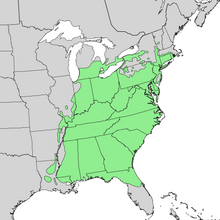
Back Tülpan ağacı Azerbaijani Tuliper de Virgínia Catalan Liriodendron tulipifera CEB Liliovník tulipánokvětý Czech Almindelig tulipantræ Danish Tulpenbaum German Tulipa liriodendro Esperanto Liriodendron tulipifera Spanish Idi-bihotz arbola Basque درخت لاله (گونه) Persian
| Liriodendron tulipifera | |
|---|---|

| |
| Liriodendron tulipifera cultivated at Laken Park in Belgium | |

| |
| L. tulipifera flower | |
| Scientific classification | |
| Kingdom: | Plantae |
| Clade: | Tracheophytes |
| Clade: | Angiosperms |
| Clade: | Magnoliids |
| Order: | Magnoliales |
| Family: | Magnoliaceae |
| Genus: | Liriodendron |
| Species: | L. tulipifera
|
| Binomial name | |
| Liriodendron tulipifera | |

| |
| Range | |
| Synonyms[2][3] | |
| |
Liriodendron tulipifera—known as the tulip tree,[a] American tulip tree, tulipwood, tuliptree, tulip poplar, whitewood, fiddletree, lynn-tree, hickory-poplar, and yellow-poplar—is the North American representative of the two-species genus Liriodendron (the other member is Liriodendron chinense). It is native to eastern North America from Southern Ontario and possibly southern Quebec to west to Illinois, and east to southwestern Massachusetts, then south to central Florida and Louisiana.
Tulip tree is the tallest tree of the temperate deciduous forest.[4] It can grow to more than 50 m (160 ft) in virgin cove forests of the Appalachian Mountains, often with no limbs until it reaches 25–30 m (80–100 ft) in height, making it a very valuable timber tree.
This species is also fast-growing, without the common problems of weak wood strength and short lifespan often seen in fast-growing species. In 2024 the unusual combination of fast-growing with strong wood was explained. No longer called a hardwood, the term "midwood" was created expressly for the wood of tulip tree.[5]
The tulip tree is the state tree of Indiana, Kentucky, and Tennessee.
- ^ Rivers, M.C. (2014). "Liriodendron tulipifera". IUCN Red List of Threatened Species. 2014: e.T194015A2294401. doi:10.2305/IUCN.UK.2014-3.RLTS.T194015A2294401.en. Retrieved 19 November 2021.
- ^ Tropicos
- ^ "The Plant List". The Plant List. 2012-03-23. Retrieved 2014-04-07.
- ^ Burns, Russell M (1990). Silvics of North America: 2. Hardwoods (PDF). U.S. Department of Agriculture. pp. 406–416. Retrieved 12 September 2024.
- ^ Wightman, Raymond (9 September 2024). "How we discovered a new type of wood — and how it could help fight climate change". The Conversation.
Cite error: There are <ref group=lower-alpha> tags or {{efn}} templates on this page, but the references will not show without a {{reflist|group=lower-alpha}} template or {{notelist}} template (see the help page).
